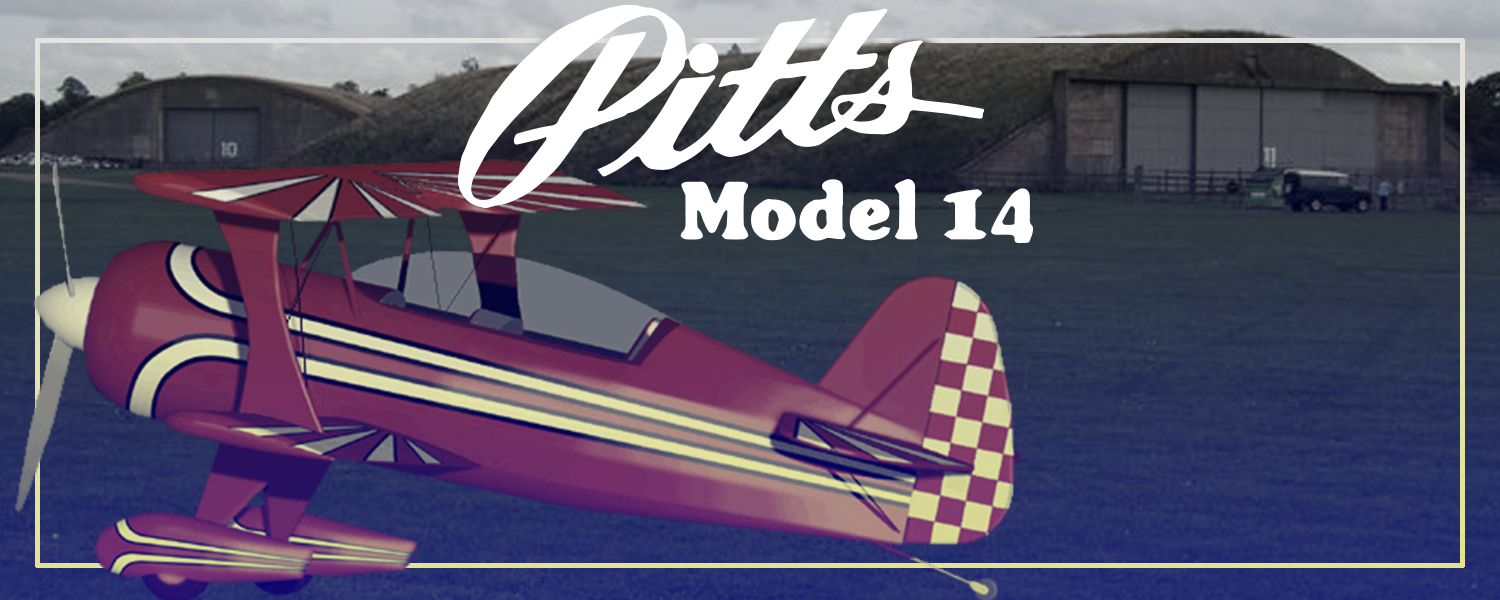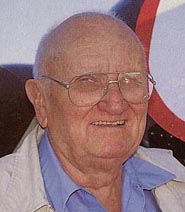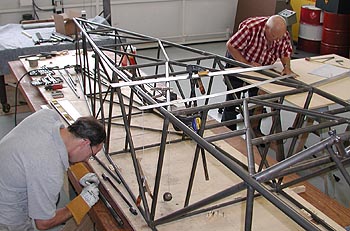
Pitts Model 14
Historical Information

Curtis Pitts (Photo courtesy of Budd Davisson, Sport Aviation 1/99)
The Pitts Model 14
Working with Curtis on a new airplane is simply a grand adventure. Here is a brief history of how the Model 14 was born.
We were talking philosophy one day, and Jere asked him “We’ve got a small favor to ask of you” and paused… “We would like you to do another airplane before you retire”. Curtis was silent for a moment and asked quietly “what kind of airplane?” “An aerobatic biplane, of course…” He paused, pensive. “That’s a lot of work” he said evenly. Still we could sense a tiny twinkle in his eyes. Over the next few weeks, he would comment “Ya know, I was thinkin’ about this new airplane idea and…”. Many of the new ideas had been in his head for some time. Incrementally his vision for the “New Airplane” gained focus.
It would have a short wingspan with a straight upper wing. He had always loved the straight wing of Samson. Someone asked “how about snap performance” with a straight upper. “Real short wings and it will snap smartly” the reply. The powerplant – Vendenyev M14P. “I’ve watched that engine for forty years” he drawled.
“Next time you boys visit, I’ve got some sketches to show you”. We were scheduled to travel to Homestead in a week or so. Expecting sketches – but there on his drafting table were rather formal three views. The lines were classic, those of a simply beautiful woman… just elegant. The elemental structural design was in place. The brace wire reactive loads are all in a single plane – along the rear spar on top and the front spar on the bottom. Simply brilliant in-line simplicity.
Over the next weeks, the architectural design began to firm up. Curtis was finishing up some drawing details on the Skybolt Radial. “I just can’t get my mind off this new airplane” he complained.
We traveled to Homestead one Sunday to pick up the old tubing nibbler Pitts Aviation had owned since ’59 or so. We were delighted when Curtis said we should have it. What a piece of history. The serial number plates are photoetched brass. It was made in the early ’20s and was designed for flat belt overhead power. The one hp repulsion-start motor is dated 1925.
Curtis had more drawings to show us. The fuse box drawings were well along. We commented the 4130 flatwork fittings were elegantly simple. “Anyone can design something complex and difficult to build”, he said. As we poured over the drawings, I noticed something. He has used the same title block on his drawings for many years. There is a box marked Model. It said 14. The Model 14 had been born.
Jere put the three views up in AutoCAD. He gave the .DXFs to Dale Hvizdo who runs the CNC group at Aircraft Shapes. Dale is a superb machinist and also a wizard with Pro-E CAD/CAM. Dale did a three-dimensional model of the airplane in Pro-E and “painted” it. We showed the 3D model to Curtis and tumbled it around in space with the touch pad. We could see the water in his eyes. I got a nice warm shiver.
One morning at breakfast, I said to Curtis “I’m really tickled to see you so excited about all this”. He said real slowly “I’ve been like this before… ’bout 13 times”.
We went completely through the nibbler, taking care to preserve all the historical detail we could. It was completely disassembled, the castings carefully stripped and redone in gray epoxy. It came out beautiful, the brass oilers gleaming like 1922. On his next visit to Steen, we told Curtis there was a new machine tool in the shop and it was our new favorite. (It wasn’t the new CNC wire EDM we had just installed).

Mark Eckenrod and Curtis work on the Pitts Model 14 prototype in late June 2003
Mark Eckenrod and Curtis work on the Pitts Model 14 prototype in late June 2003As soon as he felt the fuse drawings were stable, we put all the flatwork in CAD and punched them out on the waterjet. Curtis was now spending a week at a time at Steen Aero working the design and bossing us around. We brought him a stack of plates and fittings and we had a little “first hardware party” as we passed the humble beginnings of the Model 14 around the table.
We made a commitment to have the fuse on the gear at Oshkosh. George Coy had an engine for us. The airplane was taking shape. Curtis had finished all the fuse details and was starting the detail design on the wings. He is just amazing. He has the mind and energy of a man 25.
By late June, the fuse was nearly complete and the tail feathers were coming together in the jigs. Steve Culp came down for a few days in mid July and put another good shoulder to the rope. Steve is a good friend, a skilled builder, and very productive. He knocked out the new motor mount in a day.
And so, the Model 14 is on the gear. J.C. Taylor who runs the wood shop at Steen Aero can’t wait to get his paws on the wing plans. And we’re rather scrambling to stay up with Curtis. I’m truly amazed at his ability to get it right the first time. The engineering changes to date have been trivial. Everything fits on the numbers. He takes two steps forward and none back – the rewards of deep experience. I shared my admiration about these things. He said simply “I’ve done this before”.